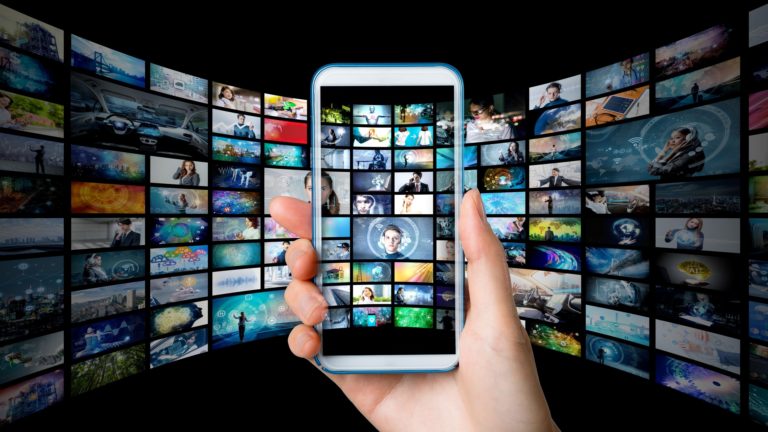Technology’s Impact to Amplify Media Plans

Why is technology important (and essential) in the media industry?
At the height of the Information Age, people are using technology to consume media more than ever before. As technology becomes more available to our society and continues to advance, so does the everyday consumer’s usage. Approximately one-third of adults in the United States report being online ‘constantly.’ Whether a consumer is plugged in for work or pleasure, screen time is on the rise, but thanks to the popularity of mobile devices, people can engage with various types of media. The average consumer spent more than seven hours with media daily across the world in 2021. In the 21st century, the lines between technology and media are connected.
Technology plays an important role in modern-day media communication. It enables advertisers to get the message in front of the right audience at the right time. Communicating with friends and family or promoting a brand’s latest product launch is now a seamless process. The media industry relies on technology to distribute brand messaging to a wider audience at a higher, faster distribution rate compared to more traditional mediums. Without technology, the advancements of the current state of the media industry would be nonexistent.
In theory, technology and media can exist without the other. However, when you optimize the use of both entities, especially in a business strategy, the dynamic duo is unstoppable. So much of our own data is being collected from technologies such as social media platforms, e-commerce websites, and more. This is to provide a better experience for the consumer and run a successful media campaign.
Measuring Media Performance: What does the data mean?
Now that we know consumers are spending more time with media and technology every day, how can we, media industry professionals, learn from the data? One person’s media usage can vary from the next, but there are tools to differentiate a consumer’s level of engagement during media usage. Impressions, clicks, views, and more are just a few of the many performance metrics to consider when making sense of a brand’s media campaign results.
Media plans are not ‘one size fits all’, it depends on a brand’s target audience, demographics, and overall objectives. Get to know your brand’s and competitors’ audiences by looking at media platforms they engage with regularly. It is ideal to integrate specific advertisements into the consumer’s established media routine and ad preferences. If your key demographic is watching the nightly news, don’t fire off advertising campaigns in the morning. Tailor your approach, know your audience, and learn from the data to maximize conversions and bring the consumer further down the marketing funnel.
The Future of the Digital Age: Artificial Intelligence
When the world shut down in 2020, the digital screens turned on. Every type of technology was integrated with media to recreate normalcies at homes such as work conferences, fitness classes, and social gatherings. Consumers also spent more time using technology and media to gain insight into what was happening in the outside world. While COVID-19 restrictions ease and society transitions back to a ‘new normal,’ digital media will continue to be a prevalent force.
A post-COVID-19 era will embrace streaming platforms, daily news intake, and telework practices. Smartphones are being used to deliver daily news updates surrounding current events. Households are getting rid of cable television and subscribing to several different streaming platforms to optimize their viewing experience. The usage of these technologies had increased when people sought out entertainment during the pandemic, however, even after restrictions have been lifted, our media intake is still climbing. This will continue to progress since artificial intelligence is becoming more common and is deemed the future of technology and media.
“Alexa, play my most-listened-to songs.” This is a command many of us are familiar with and have even said to a speaker device in our homes. Amazon Alexa is a prime example of what is in store for artificial intelligence in the media industry. Artificial intelligence was the most talked-about advancement and led to the technological forefront in 2021. So, what’s everyone buzzing about? Acritical intelligence helps people use their time more productively by freeing them from repetitive or mundane tasks. It is found in different types of software such as image analysis software, search engines, virtual assistants, and face recognition systems. It can also be embodied within robots, autonomous cars, and drones. In the next five years, artificial intelligence will completely transform the way our society functions. Brands are capitalizing on this opportunity to place their advertisements and budgets directly where the consumer is to improve user experiences. Artificial intelligence will continue to drastically improve the efficiencies of our lives.
Technology’s influence on media is profound. This unique, complex relationship has existed for centuries and continues to grow in the digital age. Understanding the metrics of media performance is necessary to stay ahead of industry trends as more consumers are engaging with media each day. The next time you’re watching a commercial on your favorite streaming series, think about the technological advancements it took to get there.






![Supplier-Diverse-logo[80] Supplier-Diverse-logo[80]](https://hoffmannmurtaugh.com/wp-content/uploads/elementor/thumbs/Supplier-Diverse-logo80-q1aarjz0bfmhzi7ttv7rocd5wxiwta6bizbjwmiync.png)